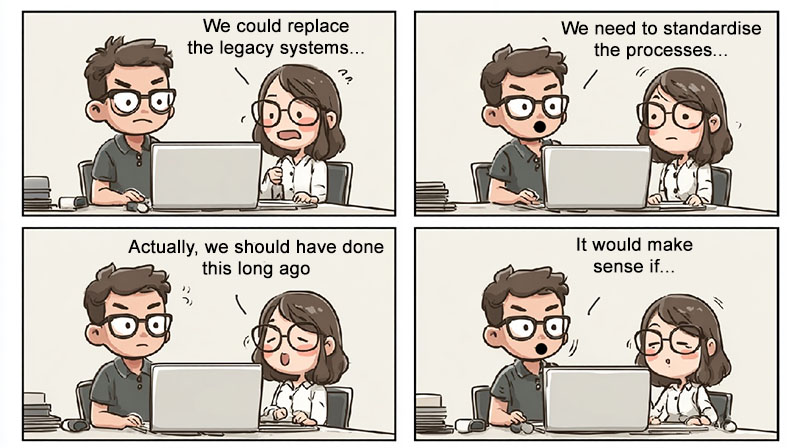The in-between in transformations
Expand the table of contents
After the strategy with the hammer and the silence of a transformation: a place where you have long since arrived
There is a place in every organisation that is more dangerous than open failure and more paralysing than complete ignorance. A place that everyone knows about but no one names. Welcome to the in-between.
You know it. That strange state when the analysis is complete, the solution is on the table, everyone nods, and then… nothing happens. ‘We know exactly what to do, but…’ That ‘but’ is the gatekeeper to the in-between. And most IT projects check in there like they’re checking into a hotel they’ll never check out of again.
The anatomy of organisational phantom pain
The ‘in-between’ is the space between insight and implementation. Between the PowerPoint slide ‘This is our future’ and the reality that stubbornly remains the present. It is neither before nor after, but the eternal in-between.
In IT, the in-between manifests itself in a particularly perfidious way:
- The migration that has been ‘80% complete’ for 18 months.
- The agile transformation project that is still ‘laying the groundwork’ in Sprint 47.
- The AI strategy that has been ‘about to be rolled out’ for two years.
- The digital transformation that is exhausted in pilot projects that never come of age.
The ‘in-between’ disguises itself as progress. It produces artefacts: roadmaps, steering committees, status reports. Everything looks like movement. But it is only a simulation of movement, like a hamster wheel with a PowerBI dashboard.
The language of the inhabitants of the in-between and the economy of eternal preparation
Listen carefully at your next steering committee meeting. The language reveals everything:
- ‘We could replace the legacy systems…’
- ‘We need to standardise the processes…’
- ‘Actually, we should have done this long ago…’
- ‘It would make sense if…’
Figure 1: The language of the inhabitants of the in-between
The subjunctive is the native language of the in-between. An entire grammar without the present tense, without the indicative, without facts. Decisions become options. Steps become scenarios. It is the perfect language for those who want to move without lifting a foot.
The in-between is no accident. It is a self-sustaining ecosystem. For every person stuck in the in-between, there are three who make a living from it:
- The interim CTO, who is already in his third year of ‘temporarily’ leading the transformation.
- The consulting firm that always needs new analyses before implementation can begin.
- The PMO, which produces status reports about status reports, while the status never changes.
The bridge to the future is getting longer and longer, but it never arrives. Why should it? On the other side, unemployment awaits all bridge builders.
The perfect temperature of stagnation and the hidden costs of the in-between
The tricky thing about the in-between is that it’s comfortable. The old world no longer presses down on you – you’ve ‘recognised’ the problem. The new world doesn’t demand anything yet – you’re ‘on your way’.
It’s like the story of the frog in the pot, except that the water never boils. It stays at that one perfect temperature. Exactly one degree above discomfort. Exactly one degree below panic. Warm enough not to move. Cool enough not to panic.
This comfort zone comes at a price:
- While you remain in the in-between, others are defining the future.
- While you are planning your cloud migration, your competitors have long since completed it.
- While you are discussing AI, others are already automating their core processes.
What does the in-between really cost? Not just the obvious costs – the consultants, the tools, the lost time. The true costs are invisible:
The loss of talent: The best leave first. They sense the stagnation beneath the simulation of movement and seek out organisations that are truly transforming, not just talking about it.
Innovation paralysis: While you debate in the in-between, you miss the next wave. First movers become fast followers, fast followers become dinosaurs.
Cultural erosion: Every day in limbo normalises inaction. ‘We’ve already tried that’ becomes the mantra. ‘It’s not that simple’ becomes the standard response.
The timeline of the in-between
Ask yourself:
- How long has your ‘transition phase’ been transitional?
- Since when has the project been ‘almost finished’?
- When did ‘quick win’ become a ‘long-term initiative’?
- In what year was the ‘temporary solution’ implemented?
The in-between has its own calendar. ‘Short sprint’ becomes three quarters. ‘By the end of the year’ – which year? Time stretches like chewing gum until it loses all its flavour.
I know organisations that have been in the ‘transformation phase’ for five years. Pilot projects that have long since come of age. Interim solutions that have developed their own legacy problems.
The uncomfortable truth and the first step
If you’ve read this far, you may recognise yourself and your organisation. That’s good. And at the same time, it’s the trap: now you’ve recognised the interim. You understand the problem. You nod knowingly.
And that is precisely the danger: the diagnosis ‘We are in between’ quickly becomes ‘We need to get out of between’. The ‘need’ becomes a ‘should’. The ‘should’ becomes a ‘could’. And just like that, you have only extended the in-between to a meta-level.
The in-between is not an external force that has afflicted your organisation. It is the sum of thousands of small acts of cowardice. Every ‘Let’s think this through again’. Every ‘We need more data’. Every ‘That’s politically difficult’.
Organisations in the in-between don’t have too little information. They have too little courage. Not too few options, but too little willingness to make decisions. Not too few resources, but too little willingness to take risks.
What now?
I could present you with a 5-point plan. ‘How to get out of the in-between.’ With a canvas and a framework and a methodology. But that would just be another map for a place you’ll never visit.
Instead, here’s a suggestion: name it. At your next meeting, when someone says ‘We should…’ again, ask: ‘Are we in the between right now?’ Make the invisible visible. Give the phantom a name.
Because the between can only hold you captive as long as you don’t know you’re captive.
The first transformation is that of perception. Everything else comes after that. Or maybe not. But at least then you’ll know where you are: In the in-between. And that, for all its tragedy, is at least a start.
Notes:
Constantin Melchers is your partner in transformation and founder of tantin Consulting. He himself spent years in limbo and knows how difficult it is to let go of the subjunctive. With his Resonance Room Workshop, he helps organisations recognise and overcome their own liminal states. Sometimes six hours of radical honesty are enough to break through years of stagnation.
Are you an opinion leader or communicator who wants to discuss the in-between in transformations? Then feel free to share this post in your network.
Constantin Melchers has published two more posts on the t2informatik Blog:

Constantin Melchers
Constantin Melchers has been supporting executives and top decision-makers at strategic turning points for over 20 years. As a consultant, former manager in various organisations and university lecturer, he combines practical experience with conceptual depth.
His approach is distinctive: strategy does not begin with planning, but with the willingness to question established patterns of thinking. ‘Many organisations fail not because of their methods, but because they imitate themselves out of habit.’
He understands transformation as a cultural act of self-overcoming, not as a management routine. With tantin Consulting, he has created a think & do tank that works selectively with medium-sized companies and organisations that are ready for real change. Instead of delivering standard recipes, he opens up spaces for resonance for sustainable change.
In the t2informatik Blog, we publish articles for people in organisations. For these people, we develop and modernise software. Pragmatic. ✔️ Personal. ✔️ Professional. ✔️ Click here to find out more.


